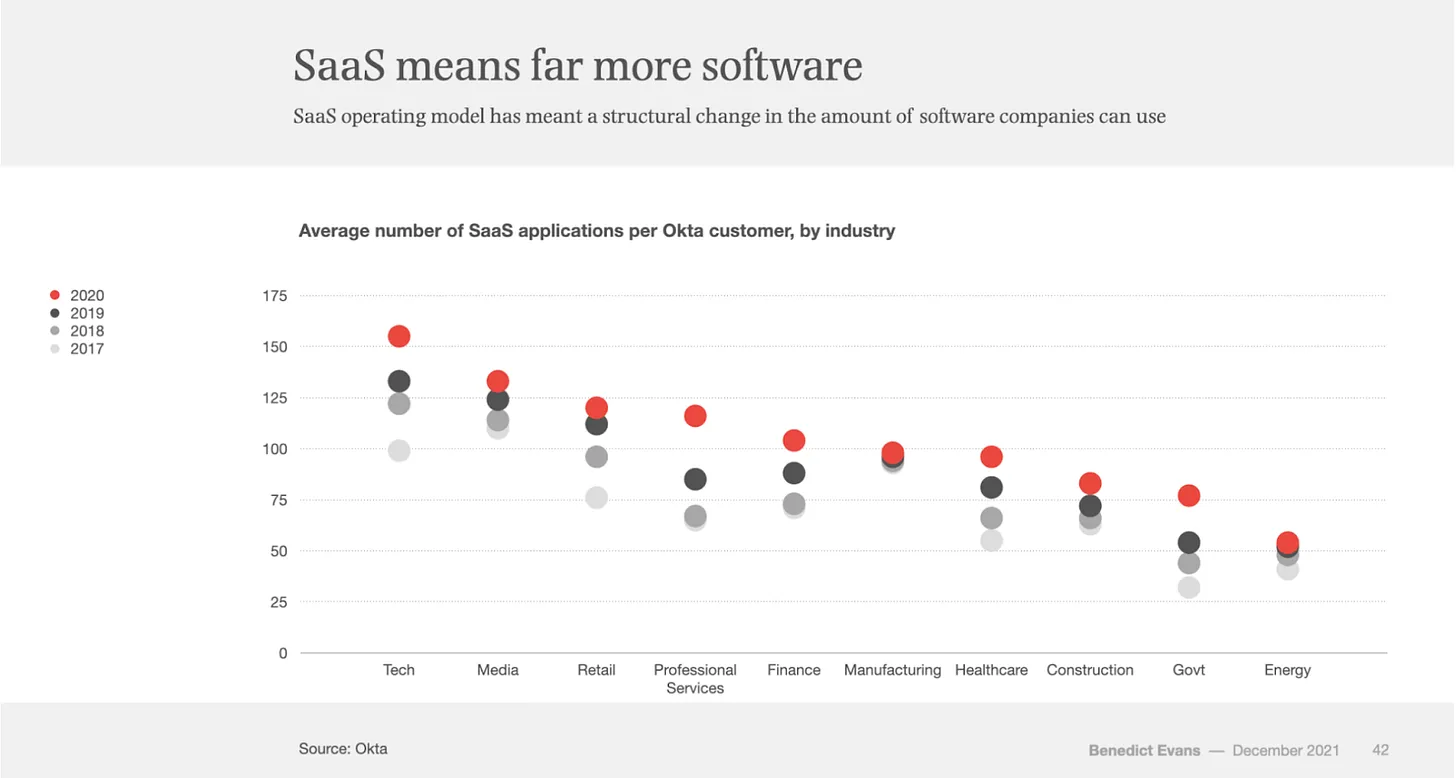What it is and what it isn't

News headlines are awash with what is a seemingly endless stream of catchphrases like “The Great Resignation”, “Quiet Quitting”, and “Metaverse.” These are weak attempts to define the unsettled future of the workplace. The purpose of this newsletter is not to predict the future, but rather to help define the role that technology may play in building that future state. We don’t know exactly what the future of work will be, but there are two things we do know for sure:
Work will continue to evolve as technology evolves
The pandemic was a massive forcing function for companies to think hard about their IT strategy in ways they previously had not
The concept of “work” has changed dramatically with the evolution of technology. We may have fewer coachman for our horse drawn carriages, but significantly more Uber and Lyft drivers. Entire industries can be created or dismantled with the advent of new technologies in ways that are hard to predict.
The creation of the smartphone and the development of the app economy gave rise to entirely new categories of companies. Companies like Uber/Lyft, Doordash, Instagram, and Venmo. Apple estimates that the iOS app economy supports 2.2 million jobs in the U.S. alone. This is even more incredible given the first iPhone launched in 2007. Raise your hand if you predicted that one.
While this is not meant to be an argument on the pertinence of Creative Destruction, suffice it to say that how we define work today will vary significantly from how future generations will. Technology will be a driving force in that change. Microsoft CEO, Satya Nadella, clearly painted this picture for us in his recent keynote address at the Microsoft Inspire conference. As he puts it (emphasis ours):
“We’re going through a period of historic economic, societal, and technological change. But for all the uncertainty we continue to see in the world, one thing is clear: organizations in every industry are turning to you and your digital capability to help them do more with less, so that they can navigate this change and emerge stronger. You are the change agents who make doing more with less possible. Less time, less cost, less complexity, with more innovation, more agility, and more resilience. Doing more with less doesn’t mean working harder or longer — it’s not going to scale — it means applying technology to amplify what you can do and ultimately what an organization can achieve amidst today’s constraints.”
Certainly these are very unsettling times for all businesses, but as a business owner where should you focus your effort to ensure you’re enabling your team to succeed? What issues will dictate where you focus your efforts?
Intertwining Work and Life 🖇
We carry supercomputers connected to the internet in our pockets. Cloud computing provides access to all our data and applications from anywhere we have cell phone service. It’s no wonder that work is increasingly intertwined with our personal lives. This flexibility means that work is no longer confined to a physical location.
As painful as it was, we learned through the pandemic that a lot of work activities can be done no matter the location. Furthermore, there can be benefits. Slack recently ran a survey of 10,000 desk workers that reported that employees with flexible schedules reported 29% higher productivity and 53% greater ability to focus than those with set hours.
It’s no coincidence that after 32 years, Microsoft is rebranding its Microsoft Office suite to Microsoft 365 – a not so subtle recognition that work is no longer confined to what’s being done in the office. Now certainly there can be negative consequences to this “always on” mentality, but the degrees of freedom software provides the workforce is change that is here to stay.

Software Productivity 🤳
Productivity is not just driven by our work schedule but also the tools with which we have to work. In previous newsletters, we described the value of building your business system through software. One of our primary takeaways from that discussion was:
“If you had to describe the evolution of the technology industry over the last 40 years in one word it would be accessibility.”

It’s certainly much more effective to let software send a thousand prospecting emails or automatically invoice each of your customers. With cloud based software we can monitor these tasks anywhere, anytime.
Yet, we know there is so much more room to grow. Companies across industries have already seen significant adoption of SaaS applications and through the pandemic this need was exacerbated by the need to work remotely.

This is the critical moment for owners and managers to analyze their business system and the opportunity to automate tasks. Where can SaaS applications make a difference in your business?
The Office is Not Extinct 🏢
We certainly are not predicting the end of the office – far from it. Most SMBs don’t have the means to let their employees work from any location on whatever schedule they want. Humans are social beings, and even us introverts require some amount of personal interaction.
There is no replacement yet for building relationships in person – body language, facial expressions, and the spontaneous interactions all play a role in creating interpersonal rapport. A study by Microsoft found that 73% of employees surveyed would go to the office more frequently if they knew their direct team members would be there or if their work friends were there (74%). The younger generations showed a particularly strong motivation to be in the office. They want the ability to connect with senior leadership (78% of Gen Z and Millennials vs. 72% Gen X and older) and their direct managers in person (80% Gen Z and Millennials vs. 76% Gen X and older). Gen Z is also particularly motivated by working in person to see their work friends (79% vs. 68% of Gen X and older).
The office will continue to be the communal gathering spot where employees create bonds and share knowledge, but the function of the office and what it means to be 9 to 5 could change significantly. With a software-defined business system the office can be more flexible in its structure and purpose for your business. Now is the time to rethink how to utilize your physical space as a gathering place for your team.
The Metaverse is Not a Solution 🕳
If you follow the tech press, even just casually, you have seen countless articles and opinions on the metaverse. But what is the metaverse? Even the most seasoned technologists have trouble agreeing on the definition. One of our favorite technology analysts, Benedict Evans, describes the challenge this way:
“We probably don’t know what ‘metaverse’ means. More precisely, we don’t know what someone else means. This word has become so vague and broad that you cannot really know for sure what the speaker has in mind when they say it, since they might be thinking of a lot of different things…Instead ‘metaverse’ has taken on a life of its own, absorbing so many different concepts that I think the word is now pretty much meaningless - it conveys no meaning, and you have to ask, ‘well, what specifically are you asking about?”
It’s easiest to think of the metaverse as an immersive digital experience which is generally accessed through a virtual reality headset. This is essentially a new digital means for us to communicate and interact with people. Mark Zuckerberg describes the metaverse as the ultimate expression of social software given that anyone, anywhere in the world can meet and interact in a digital realm.
Zuck, who went so far as to rebrand the entire company from Facebook to Meta, admits that his vision is still many years away and that it is set up for the trough of disillusionment. But the company is spending billions of dollars on virtual reality devices, software development, and creating use cases for businesses and consumers alike. The company has partnered with other major technology companies including Microsoft, Adobe, and Autodesk to create new experiences and capabilities for business users. Will this change how people connect and communicate? Will these devices reach the mainstream or be utilized more narrowly? All of this remains to be seen, so for now we get to be casual observers rather than definitive champions.
Conclusion
There is no singular answer for how companies will operate in a post-pandemic world, but one thing that is certain is that change is inevitable and technology will continue to change the means and meaning of work. Most importantly for business owners is recognizing the role of software in your company strategy. Software enables your company to be more flexible, nimble and resilient. These are important attributes when navigating challenges such as global pandemics, recessions, inflation, and tight labor markets. Our focus does not need to be on creating the future but rather taking advantage of what the future has to offer us. If you take away nothing else from this post, reflect on how Steve Jobs described the impact computers would have on work in 1990.
